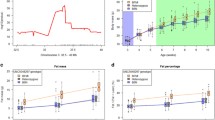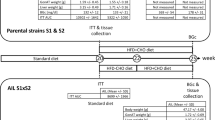Abstract.
A genome-wide quantitative trait locus (QTL) analysis was performed in a polygenic obesity mouse model resulting from a long-term selection experiment. The parental lines were outbred lines divergently selected for 53 generations for high-fat (fat, F line) or low-fat (lean, L line) percentage (fat%) that differed fivefold in fat% at 14 weeks of age. An F2 population of 436 mice was used for the QTL analysis with 71 markers distributed across the genome. The analysis revealed significant QTLs Fob1 (for F-line obesity QTL 1), Fob2, Fob3, and Fob4, on Chromosomes (Chrs) 2, 12, 15, and X, respectively. None of these QTLs map to regions of known single gene obesity mutations (Lep ob , Lepr db , Cpe fat , A y , tub), though they map to regions of previously described obesity QTLs and candidate genes. The effects of Fob1, Fob3, Fob4 were additive, and that of Fob2 was dominant. Fob2 also showed a significant female-specific effect. Fob1, Fob2, Fob3, and Fob4 explained 4.9%, 19.5%, 14.4%, and 7.3% of the F2 phenotypic variance for fat%, respectively. This study identified four loci that contributed to the response to divergent selection and control a significant proportion of the difference in obesity between the F and L lines.
Similar content being viewed by others
Author information
Authors and Affiliations
Additional information
Received: 28 May 1999 / Accepted: 31 August 1999
Rights and permissions
About this article
Cite this article
Horvat, S., Bünger, L., Falconer, V. et al. Mapping of obesity QTLs in a cross between mouse lines divergently selected on fat content. Incorporating Mouse Genome 11, 2–7 (2000). https://doi.org/10.1007/s003350010002
Published:
Issue Date:
DOI: https://doi.org/10.1007/s003350010002




